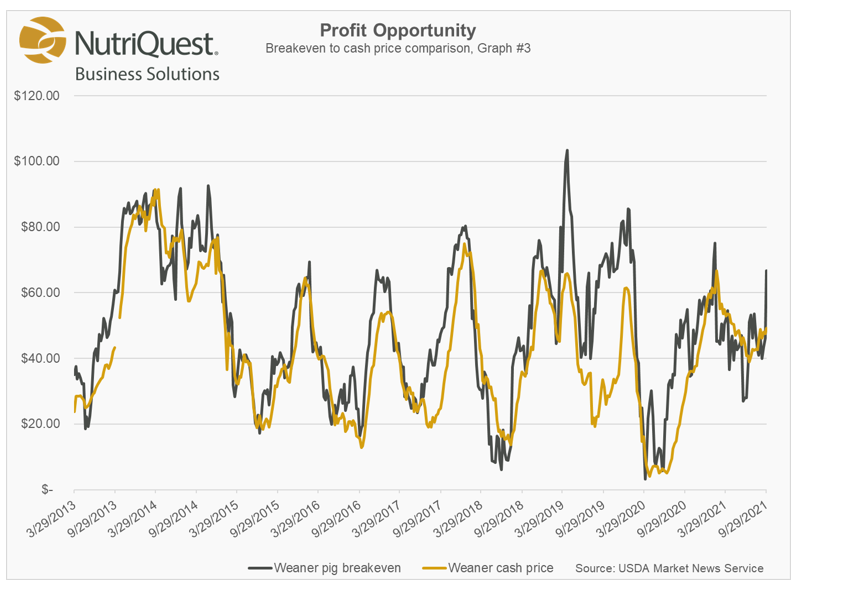CAB Insider: Feedyard Performance Slips as Costs Rise
Heavy winter precipitation has continued at intervals spanning December through early March while brutally cold temperatures add often devastating effects, and sub-zero readings continued this week in many areas. The full impact has yet to be measured in the feedlot sector but average daily gains and feed conversion ratios on pen closeouts are starting to reveal the trend. Shawn Walter, respected analyst with AgStrata, says feedlot cost-of-gain (see chart) has developed an upward slope based on early 2019 cost data from their member feedyards. While the long-term cheapening trend turned a bit higher in 2018, we expect closeouts for the next several months to reflect heavy weather impacts on efficiency and gain. Feedyards placing cattle in the fall will see cost adjustments in a wide range, varying by location, but likely up to 10¢/lb. of gain over initial projections. January closeout data gives us a glimpse of the earliest impacts, with steer costs of gain already ratcheting 5¢/lb. higher than a year ago. Dry-matter feed conversions in AgStrata member feedyards were reduced by a quarter-pound of gain per pound of feed in the January year-on-year comparison as well. Days on feed (DOF) have partially made up for some of the lost performance, according to Walter, bringing steer finished weights in the Northern Plains to within 1 lb. of a year ago in January to average 1,458 lb. Nationally, January closeouts indicated an average of 180 DOF compared to 168 a year ago. The rate of decline in carcass weights to the anticipated spring low near May 1st is a key component to prices in both the boxed beef and fed cattle markets. Bear in mind that as feedyards in the most weather-impacted areas begin to thaw out in the spring, environmental performance challenges do not disappear as muddy pens will reappear.
Market Update
Last week’s fed cattle market was a bit disappointing in terms of cattle feeder expectations, but felt like a partial win nonetheless. The resulting $128/cwt. weighted average fed-cattle price was a $2/cwt. increase on the week prior, and more closely aligns the cash cattle price with the nearby (April) Live Cattle futures contract price of $129.55/cwt. at Friday’s market close.
USDA reports continue to update on the heels of the government shutdown and reopening. The latest report for the week ending February 16th showed steer carcass weights 2 lb. lighter than a year ago at 879 lb., with heifer carcasses 9 lb. lighter at 819 lb. apiece. Considering the weather, it’s a curiosity that steer weights are only 2 lb. under last year at this point. Since Jan. 1, Certified Angus Beef brand carcasses are running 6 lb. lighter in the year-on-year comparison. Acceptance rates are at 36.6% in the past 8 weeks compared to 34.1% for that period a year ago. In the same 8-week comparison, certified weekly head counts averaged 97,300 head versus 82,700 a year ago.
Much of what we discussed about the boxed beef complex two weeks ago has begun to develop here in early March. Recent years have shown a fairly strong March increase in cutout values and it would appear we’re on the cusp of those now as protein buyers begin to fill inventory needs ahead of spring demand. We should see a notable spike in beef values into the third week of March before the pattern begins to retreat into mid-April. Bear in mind we’re simply observing history and not trying to predict exactly what will transpire this year on a specific timeline. The Choice/Select spread widened a bit last week to $4.47/cwt. on Urner Barry’s weekly average, while the CAB/Choice spread is more than twice that at $9.83/cwt.
The strength of the rib is still evident in this market as that primal increased by $10.90/cwt. in last week’s reports. CAB lip-on ribeyes at $8.45/lb. in the wholesale spot market were 59¢/lb. higher than a year ago. The loin complex was next in line in terms of upward price adjustment, with strip loins leading that charge and already headed onto that steep upward slope that should continue in the short term. Loin items seeing some weakness included top butts and ball tips, while flap meat and tri-tips were higher. The report shows end-meat pricing as a mixed bag with chuck and round items up and down in a choppy pattern, depending on the item. Ground chuck was priced higher, yet ground round and sirloin were both lower last week.
Early Spike in Beef Buying Buoys Cutout Value
There are relatively few occasions in a typical year when a mass of protein buyers step into the market in full force to secure a volume of beef for future delivery. The week of February 11th will likely mark the largest forward contract week of 2019, given the magnitude of that particular week at 970 loads compared to last year’s high of 939 loads, achieved in April.
A quick study of annual boxed beef cutout values in normal market years, absent any supply impacts, will show buyers a fairly predictable calendar layout of seasonal price expectations. A look at the comprehensive forward contract volume chart shows the spike in contract volume in early February. This buying behavior is logical considering the accompanying CAB boxed beef cutout value chart which, based on history alone, would prompt buyers to step into the market ahead of the spring cutout run-up. Now, that’s not to say packers are willing to price product for 60-90 days out at early February prices, but they’ll certainly add a premium in line with seasonal demand projections. Still, odds are decent that a favorable price environment exists with commitment ahead of the curve rather than behind it in the spot market.











